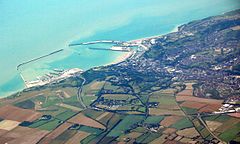The Channel Ports are seaports in southern England and northern France, which allow for short crossings of the English Channel. There is no formal definition, but there is a general understanding of the term. Some ferry companies divide their routes into "short" and "long" crossings. The broadest definition might be from Plymouth east to Kent and from Roscoff to Zeebrugge although a tighter definition would exclude ports west of Newhaven and Dieppe. A historic group of such ports is the Cinque Ports of south-east England, most of which have ceased to be commercial ports.
Ports
England

The ports vary in size and their relative importance has fluctuated during recent history. Dover has established a lead in the cross-Channel ferry routes through its geographic position and development of its facilities and hinterland. This business has been sustained despite competition from the Channel Tunnel. Other minor ports in Kent and Sussex have retained some trade but these tend to be single routes, such as Newhaven–Dieppe.
Longer routes mainly radiate from Portsmouth but there are lesser ports at Poole and Plymouth, with routes to Normandy, Brittany and Spain.
France
The major French port with cross-Channel connections is Calais, with frequent sailings to Dover. Other close French channel include Dunkirk and Dieppe.
Longer routes are served from Le Havre, Caen, Cherbourg, Roscoff and St Malo. There are services to Ireland (Rosslare and Cork).
Strategic importance
The ports are important commercial facilities, reinforcing connections between the British and European road systems. They are also vulnerable to industrial action such as strikes by port employees or blockades by disgruntled fishermen.
Their importance as military facilities was demonstrated during two World Wars.
World War I
During World War I the British and French Channel ports were major conduits for British materiel and troops.
The Belgian ports of Ostend and Zeebrugge were considered a major threat by British Admiral Admiral Jellicoe. He was concerned by their use not only as German U-boat ports, but also as torpedo boat bases and even possible departure points for a cross-Channel attack. This concern was transmitted via Whitehall to the British chief of staff on the Western Front, General Haig, for whom it merely confirmed the need for an offensive in Flanders, and eventually led to the Battle of Passchendaele (also known as the Third Battle of Ypres).
World War II
During World War II, likewise, the Channel ports provided major supply routes which had to be reopened in 1944. Dunkirk was the route from which British and Allied troops were evacuated in 1940; see Dunkirk evacuation. Dunkirk was left under siege until the general German surrender.
In September 1944, the First Canadian Army (Canadian, British, Polish, Czechoslovak and other national units) was to capture the ports from Le Havre to Zeebrugge. Dieppe and Ostende were undefended but major military actions were required for Le Havre (Operation Astonia), Boulogne (Operation Wellhit) and Calais (Operation Undergo). It took several weeks to bring the ports back into use at a time when Allied armies badly needed supplies.
See also
- Operation Stack
- List of ports and harbours of the Atlantic Ocean
- Cinque Ports (in England)
- France–UK border
References
Notes
- "Channel Ferry Ports linking England and France". visitFrance. 2002–2009. Archived from the original on 10 March 2009. Retrieved 15 July 2009.
- "Dover-Calais/Boulogne ferry services hit by strike". eTravel.org. 16 October 2008. Archived from the original on 14 April 2013. Retrieved 15 July 2009.
- "Ports blocked in cod quota protest". CNN. 11 December 2002. Retrieved 15 July 2009.
- Strachan, Hew. The First World War. Pocket Books, 2006, pp. 244–5.
- Stacey. "Clearing the Coastal Belt and the Ports, September 1944". Department of National Defence. Retrieved 15 July 2009.
Bibliography
- Cowsill, Miles; Hendy, John (1994). Newhaven-Dieppe: the car ferry era. Kilgetty, Pembrokeshire: Ferry Publications. ISBN 1871947200.
- Cowsill, Miles (1997). Ferries of The English Channel: Past and Present. Kilgetty, Pembrokeshire: Ferry Publications. ISBN 187194743X.
- Hendy, John (1991). The Dover–Ostend Line. Staplehurst, Kent: Ferry Publications. ISBN 095135065X.
- Hendy, John (1993). Ferries of Dover. Staplehurst, Kent: Ferry Publications. ISBN 0951350692.
- Hendy, John (1997). Ferry Port Dover: the development of cross-channel vehicle ferries, their services and allied infrastructure. Staplehurst, Kent: Ferry Publications. ISBN 1871947472.
- Hendy, John (2009). Dover-Calais: The Short-Sea Route. Ramsey, Isle of Man: Ferry Publications. ISBN 9781871947939.
- Hendy, John (2014). Folkestone: for the Continent. Ramsey, Isle of Man: Ferry Publications. ISBN 9781906608767.
- Hendy, John (2016). Dover-Calais. Ramsey, Isle of Man: Ferry Publications. ISBN 9781906608743.
- Pattheeuws, Stephen (2015). The Ostend Ferry: from start to finish. Ramsey, Isle of Man: Ferry Publications. ISBN 9781906608804.
- Searle, Brian; Peter, Bruce (2010). Weymouth Ferries: The Rise and Fall of a Port. Ramsey, Isle of Man: Ferry Publications. ISBN 9781906608088.
External links
- A commercial site promoting cross-channel traffic
- List of ferry routes to England
- List of ferry routes to France Archived 13 October 2012 at the Wayback Machine
| Ports and harbors | |
|---|---|
| Types | |
| Rankings | |
| Locations | |
| Port management | |
| Conventions | |